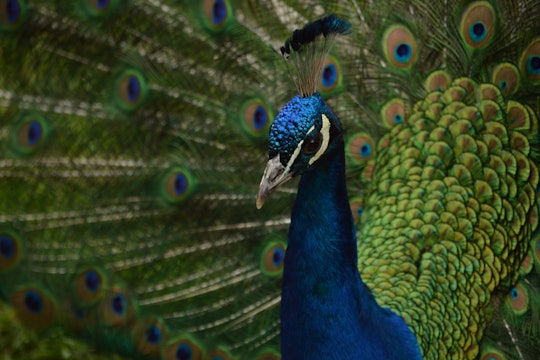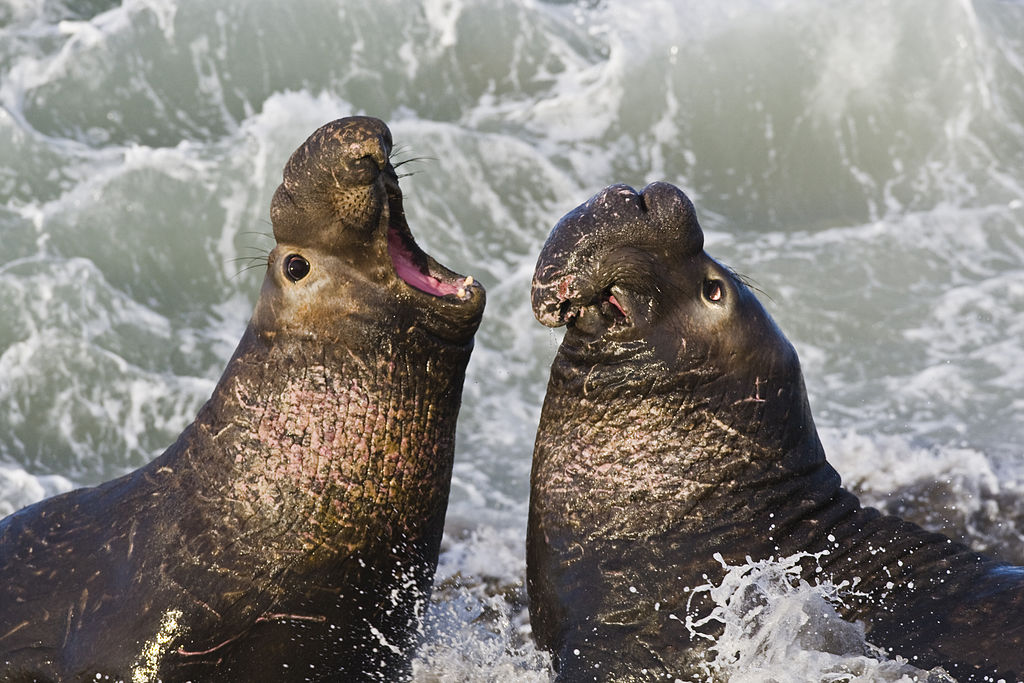
Photo by Hannes Wolf on Unsplash
When evolution's path leads to a dead end
The fossil record shows that nature doesn't always make the right choices
Seventy million years ago, in a warm shallow sea, swam an ostracod – a tiny bean-shaped creature, no bigger than a grain of sand. The intricate features of his long, smooth shell, or carapace, identify him as K.cushmani. His carapace hid and protected his delicate body – like a shrimp stuffed inside a clam shell – as he propelled himself with scrabbling legs toward the bacteria he fed on. Around him swam hundreds of other ostracods, just like him, though the females were slightly fatter. Unbeknownst to our K. cushmani, this gender difference in body shape – known as sexual dimorphism – marked him and his kind for failure.
Sexual dimorphism describes these physical – or morphological – differences between males and females of the same species. Differences might include size or shape of the body, color, or ornamentation. Think of the peacock with his iridescent feathery fan compared with the subdued colors of the peahen; the male elephant seal with his enormous bulk and bulbous nose, compared with his relatively slender female counterpart; or the moose and his impressive antlers, where the female has none.

That bulbous nose: irresistible
Wikimedia Commons
Sexual dimorphism is a result of males and females diverging down different evolutionary paths through selection processes, such as competition to reproduce. These processes happen for a variety of reasons. In some cases, strong colors in male birds are a sign of health. The elephant seal’s bulbous nose allows him to roar loudly to defend his territory – and his harem. And the moose’s antlers are used to intimidate or fight other males. Sexual dimorphism is the end result of choices made by mating partners and can increase the likelihood of reproduction: I would bet on the moose with the biggest antlers, wouldn’t you?
But what about the long run? What’s the impact on survival of the species? There are conflicting theories about whether sexual dimorphism is a good plan for a species. On the one hand, previous research by scientists at the University of East Anglia in the UK argued that selection processes – including those that lead to sexual dimorphism – weed out disadvantageous genes, improving adaptation and increasing the chances of species survival. But on the other hand, investing heavily in selections that benefit reproduction may come at an evolutionary cost, reducing a species’ overall ability to adapt and survive.
Think of those brightly colored birds. Yes, they’re attractive to females, but they are also easy for predators to spot. So males may inadvertently reduce their likelihood of survival. "Well," you may say, "males aren’t such a big deal. It takes only a few males to keep a population ticking along." But sometimes males can also reduce the evolutionary fitness of females. For example, researchers from Tufts University showed that the ejaculates delivered with fruit fly sperm can cause female fruit flies to avoid mating again, reducing the number of offspring. This is a much more damaging impact for a species.
So is sexual dimorphism advantageous or not? This was the question that ecologist John Swaddle of the College of William and Mary was trying to tackle by studying birds. But he was confounded by the problem that it’s not possible to study extinction risk directly in living species; the best we can do is look at proxies for extinction, like population decline. But even if a species is clearly under evolutionary stress, how do we know that extinction will be the outcome until it happens? How can we be sure of the ultimate effects of interacting drivers of environmental change, competition, and resource pressures.
The answer is: we can’t. That’s where paleontologists Rowan Lockwood of the College of William and Mary, Gene Hunt of the Smithsonian, and Markham Puckett of the University of Southern Mississippi came in. Hunt had been focusing on fossil ostracods – one of the few taxa where sexual dimorphism can be readily identified in the fossil record. And they brought in Maria João Fernandes Martins, an ecologist who had studied reproduction in living ostracods at the Swiss Federal Institute of Aquatic Science and Technology (Eawag) in Zurich. Now, she would tackle similar questions in their fossil counterparts.
“I thought, if we can answer the question, it’s with this study,” Fernandes Martins said.
The fossil record is our history book of Earth’s extinct species. It’s not a perfect record. In fact, it’s pretty awful. It’s both incomplete and poorly preserved, as if someone had ripped out 950 pages from a 1,000-page book, and the ink on remaining pages is smudged. Fossils are only preserved in the most fortuitous of circumstances: where there is water, when organisms are buried quickly, when there is limited oxygen, when the creatures have hard parts that don’t easily fall apart. So our fossil record is only a fraction of the story. But nonetheless, it’s the record we have. And in some cases, like ostracods, it’s quite handy.
Ostracods have been around for almost 500 million years – not long after multicellular life first bloomed on Earth. And they’re remarkably resilient, still living today in almost every wet environment: open oceans, freshwater rivers and lagoons, caves, hot springs, even in groundwater. But you’d hardly know they’re there. Ostracods are tiny. Most are a fraction of a millimeter long. But they’re abundant, which is one of the things that makes them so useful. In fact, there are a bunch of things that make these little guys useful: there are often large numbers of individual ostracods preserved, making them great for statistical studies; they have a hard carapace that is often well preserved and which is different in different species; many, but not all, species have sexually dimorphic carapaces; and there are many well-documented extinct species from different environments and time periods.
The team of researchers set about studying 93 species of extinct ostracod, featured in a recent study published in Nature. Under a binocular microscope, Fernandes Martins and her colleagues photographed thousands of individual ostracods that lived in the late Cretaceous, from about 84 to 66 million years ago.They then painstakingly digitized the outlines of each, which were then used to measure the length-to-width ratios – the shape and size – of different species. In most species, differences in shape and size very cleanly distinguish males and females. How did they know these differences relate to genders, and which was which? Because many species of ostracods are still alive today. So they were able to compare characteristics of extinct ostracod species with the abundant living species.
The next step was to figure out what correlation, if any, existed between sexual dimorphism and how quickly species became extinct. To do this they used a computational model that is commonly used in living wildlife studies – a catch-mark-release model designed to look at individuals, how long they live, and where they go. The model was adapted to fossil studies, where it is increasingly being used, so that instead of individuals, the model assesses species. And instead of life spans, it models extinction rates. For over 6,000 individual ostracods, the team recorded the size, shape, and species of each fossil, and when they lived – by looking at where they occurred in the rocks. The software used all of this data and different combinations of these factors to generate hundreds of models, assessing how well each model predicted the likelihood of extinction.
It turns out that sexual dimorphism correlates extremely well with increased extinction rate, with more than 99 percent of models correlating the two. But it’s not sexual dimorphism itself that’s the problem – it’s the type of sexual dimorphism. Only where males were larger or more elongate than females was the extinction rate higher. In living ostracods, larger or more elongate male carapaces are used to house larger sex organs. So by analogy, for the fossil species, males that invested more resources in reproduction did so at significant evolutionary cost.
The study showed that extinction rates in ostracods with the most pronounced sexual dimorphism of this type were 10 times higher than those with the least pronounced dimorphism. And while the researchers expected some correlation, “I never expected it to be so clear, so strong,” said Fernandes Martins.
So those ostracod species where males invested heavily in sexual selection chose poorly, it seems. Evolutionary stresses impacted them more than ostracods with more similar genders, sending them quickly into the evolutionary history books.
Does this mean the same applies to other taxa that show sexual dimorphism? That’s a hard question to answer, because it leads us back to the same old problem of assessing extinction risk in living species. But research on living species has led to increasing evidence that specialization does correlate with extinction rates.
Although specialization allows species to be highly adapted to their environment, it doesn’t mean they’re adaptable. If conditions change, they are likely to be more at risk. And this doesn’t apply just to morphological specialization – like sexual dimorphism – but specialization generally: in habitat, geographic range, maturation age, behavior, and environmental tolerance. In previous research, scientists from the University of Miami gave many examples, such as thermal specialization, which is linked with population decline in lizards. Researchers have noted many examples of specialized species that are, or would be, under increased stress with changes to their environment: changes such as temperature, water chemistry, habitat reduction, prey diversity, or volume. In fact, scientists from the Muséum National d’Histoire Naturelle in Paris have proposed that there is already a worldwide decline in specialist species as a consequence of human impact.
It’s easy to view the progress of evolutionary selection as one-directional – leading toward ever more refined and useful traits. In Darwin's words, “natural selection will tend to render the organization of each being more specialized and perfect, and in this sense higher.”
But nature does not always make the right choices. Sometimes those choices lead to evolutionary dead ends.
Ostracods' message to us is that sexual dimorphism can be a major risk factor for extinction. And while it’s not necessarily a death sentence – while there are many factors that contribute to the survival of a species – in these times of marked human impact on natural ecosystems, it just might pay to take special care of our specialized friends.
